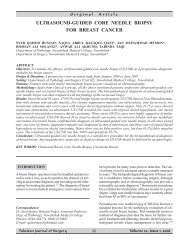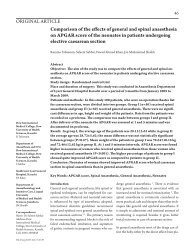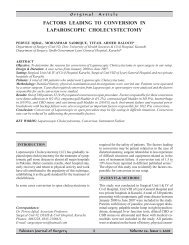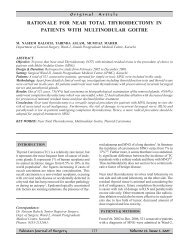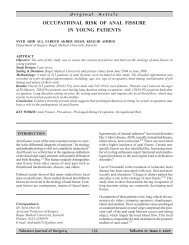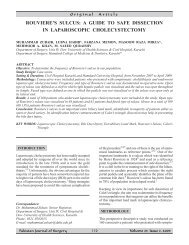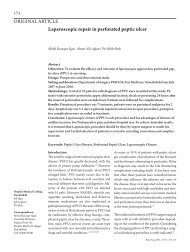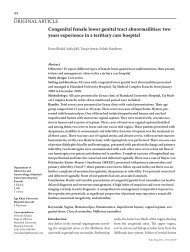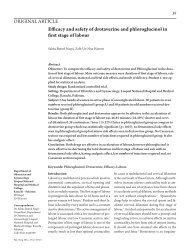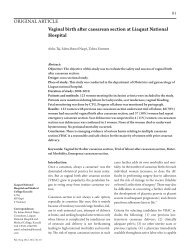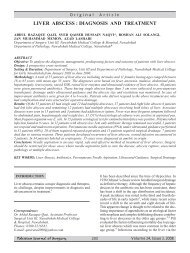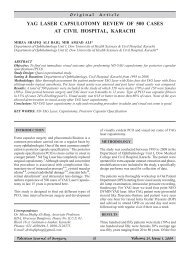CAUSES OF OBSTRUCTIVE JAUNDICE
CAUSES OF OBSTRUCTIVE JAUNDICE
CAUSES OF OBSTRUCTIVE JAUNDICE
Create successful ePaper yourself
Turn your PDF publications into a flip-book with our unique Google optimized e-Paper software.
Original<br />
Article<br />
<strong>CAUSES</strong> <strong>OF</strong> <strong>OBSTRUCTIVE</strong> <strong>JAUNDICE</strong><br />
JAVERIA IQBAL, ZAHOOR KHAN, FARYAL GUL AFRIDI, ABDUL WAHAB JAMSHED ALAM,<br />
MOHAMMAD ALAM, MOHAMMAD ZARIN, MOHAMMAD AZIZ WAZIR<br />
Department of Surgery, Surgical ‘D’ Ward, Khyber Teaching Hospital, Peshawar<br />
ABSTRACT<br />
Objective: To evaluate the causes of obstructive jaundice in our set-up.<br />
Design & Duration: Prospective, cross sectional study from July 2005 to December 2006.<br />
Setting: Surgical ‘D’ Ward, Khyber Teaching Hospital, Peshawar.<br />
Patients: A total of 50 cases of obstructive jaundice were included in the study. Patients who were lost to follow-up<br />
were excluded.<br />
Methodology: All cases were thoroughly investigated and their cause established. Different procedures were performed<br />
and the patients discharged home after their condition stabilized. They were followed-up and assesed for short and<br />
long term complications.<br />
Results: Out of the total 50 patients half (25) were males and the rest females. Their age of the patients ranged from<br />
46 to 93 years. All patients had jaundice, while abdominal pain, pruritis and abdominal mass were other presenting<br />
complaints. The causes of obstructive jaundice included gall stones in 20 (40%) patients, mass head of pancreas in<br />
16 (32%), and biliary strictures in 4 (8%) cases while hepatic abscesses, pseudopancreatic cyst, cholangiocarcinoma,<br />
choledochal cyst and periampullary carcinoma each accounted for two cases.<br />
Conclusion: Obstructive Jaundice is commonly caused by gall stones, pancreatic tumours, biliary strictures and<br />
malignancies in our set-up.<br />
KEY WORDS: Obstructive Jaundice, Gall Stones, Pancreatic Carcinoma, Biliary Strictures<br />
INTRODUCTION<br />
Obstructive jaundice results from biliary obstruction,<br />
which is blockage of any duct that carries bile from<br />
liver to gall bladder and then to small intestine. 1 Therefore<br />
the causes of obstructive jaundice can be intrahepatic<br />
or extrahepatic. Hepatitis, cirrhosis and hepatocellular<br />
carcinoma are the commonest intrahepatic<br />
causes. 2 Extrahepatic causes are subdivided into intraductal<br />
and extrahepatic aetiologies. Neoplasms, choledocholithiasis,<br />
biliary strictures, parasites and primary<br />
sclerosing cholangitis leads to intraductal obstruction.<br />
External compression of biliary channels by neoplasms<br />
pancreatitis, and cystic duct stones with subsequent gall<br />
bladder distension leads to extraductal obstruction. 3-6<br />
Correspondence:<br />
Dr. M. Zarin, Senior Reg., Surgical ‘D’ Ward,<br />
Khyber Teaching Hospital, Peshawar.<br />
Phones: 091-9216340, 0333-9414477.<br />
E-mail: drmzareen@yahoo.co.uk<br />
Obstructive jaundice, caused by stones, is a common<br />
disorder. 7,8 Stones in the common bile duct occurs in<br />
10-15% of patients with gall stones. These stones account<br />
for more than 80% of common bile duct stones; they<br />
migrate from the gall bladder and are similar in appearance<br />
and chemical composition to the stones found elsewhere<br />
in the biliary tree. Primary bile duct stones may<br />
develop infrequently within the common bile duct many<br />
years after a cholecystectomy and starts as accumulation<br />
of biliary sludge consequent upon dysfunction of<br />
the sphincter of Oddi. In far East countries, CBD stones<br />
are thought to follow bacterial infection secondary to<br />
parasitic infestation with Clonorchis sinensis, Ascaris<br />
lumbricoides or Fasciola hepatica. 9<br />
In investigating obstructive jaundice, ultrasonography<br />
is the gold standard examination. 2 It gives clues for further<br />
investigations including CT scan, Magnetic Resonance<br />
Cholangio-pancreaticography (MRCP), Endoscopic<br />
Retrograde Cholangiopancreaticography (ERCP),<br />
and Percutaneous Cholangiography (PTC). Much work<br />
is on going in the management of obstructive jaundice,<br />
and its treatment modalities have changed from open<br />
cholecystectomy and exploration of the common bile<br />
12<br />
Volume 24, Issue 1, 2008
Causes of Obstructive Jaundice<br />
Obstructive jaundice is equally prevalent among males<br />
and females. Its main causes are gall stones and maligduct<br />
(CBD) to ERCP and laparoscopic procedures. 10-12<br />
PATIENTS & METHODS<br />
This study was carried out on obstructive jaundice patiadmitted<br />
to the Surgical ‘D’ ward of Khyber Teaching<br />
Hospital, Peshawar. A proforma was designed which<br />
included information about the demography of patients,<br />
symptoms and signs, confirmatory investigations, diagnosis,<br />
treatment, follow-up and the outcome.<br />
The proformas were filled by doctors. Patients who<br />
could not be followed-up were excluded from the study.<br />
All the data collected was compiled and then systematically<br />
analyzed.<br />
RESULTS<br />
A total of 54 patients were seen during the study period<br />
with obstructive jaundice. Out of these four were lost<br />
to follow-up and were excluded. Of the remaining 50<br />
patients, half were males and half females. Their ages<br />
ranged from 46-93 years, the mean age being 62 years<br />
(Table I). All patients presented with jaundice; 34 had<br />
abdominal pain, 23 pruritis and eight abdominal mass<br />
also. The causes of obstructive jaundice included gall<br />
stones in 20(40%) patients, mass head of pancreas in<br />
16(32%) and CBD strictures in 4(8%) patients as shown<br />
in Table II.<br />
DISCUSSION<br />
In our study we discovered that the incidence of obstructive<br />
jaundice was more common amongst middle<br />
aged patients. Gall stones were the aetiological cause<br />
in 20 (40%) patients and malignant tumours in 16 (36%).<br />
cases. Khurram et al also noted gall stones as the commonest<br />
cause of biliary obstruction 1 in their study.<br />
Stone disease was more common among females in this<br />
Table I. Age Incidence<br />
J. Iqbal, Z. Khan, F. G. Afridi, A. W. J. Alam et al<br />
study, while neoplasia was mostly seen in males; a finding<br />
similar to that of other workers. 2 Vargus and Astete<br />
also reported that choledocholithiasis and neoplasia of<br />
the common bile duct ranked as first and third common<br />
diagnosis respectively amongst male patients undergoing<br />
ERCP. 3<br />
Tumours causing biliary channel obstruction are generally<br />
ampullary carcinomas, gall bladder carcinomas<br />
extending into the CBD, metastatic tumours (usually<br />
from the gastrointestinal tract or the breast), secondary<br />
lymphadenopathies at the porta hepatis and cholangiocarcinomas.<br />
4 In our study neoplastic obstructions were<br />
mainly caused by pancreatic tumours; the remaining<br />
being cholangiocarcinomas and the lymphadenopathies<br />
causing extrinsic pressure on the CBD. Biliary related<br />
malignancies occur equally in both sexes. 5<br />
Choledochal cysts were seen in 4% of our cases. They<br />
are congenital cystic dilatations of extra and intra-hepatic<br />
biliary tree, or both. Cholechodal cysts are prevalent<br />
more in Asia, especially Japan, and are 3-4 times more<br />
common in females. 1,6<br />
Retained biliary stones and strictures caused post-cholecystectomy<br />
jaundice in five of our patients. Other authors<br />
also found CBD ligation and traumatic strictures<br />
as the commonest cause of obstructive jaundice after<br />
cholecystectomy. 7,8 Benign non-traumatic inflammatory<br />
stricture of the common bile duct (CBD) may result<br />
in obstructive jaundice which can be misdiagnosed as<br />
a neoplastic lesion 9 ; however malignant strictures of<br />
the biliary tree are not that common. 12<br />
CONCLUSION<br />
Table II. Causes of Obstructive Jaundice<br />
Cause<br />
No.<br />
%<br />
Age Group<br />
40-50 years<br />
50-60 years<br />
60-70 years<br />
70-80 years<br />
80-90 years<br />
> 90 years<br />
No.<br />
6<br />
16<br />
20<br />
4<br />
2<br />
2<br />
%<br />
12<br />
32<br />
40<br />
8<br />
4<br />
4<br />
Gall Stones<br />
Ca. Head Pancreas<br />
Biliary Strictures<br />
Liver Abscess<br />
Pseudopancreatic Cyst<br />
Cholangiocarcinoma<br />
Peri-ampullary Ca.<br />
Choledochal Cyst<br />
20<br />
16<br />
4<br />
2<br />
2<br />
2<br />
2<br />
2<br />
40<br />
32<br />
8<br />
4<br />
4<br />
4<br />
4<br />
4<br />
13<br />
Volume 24, Issue 1, 2008
Causes of Obstructive Jaundice<br />
nancies. Choledocholithiasis is more common among<br />
females and neoplastic lesions among males.<br />
REFERENCES<br />
1. Khurram M, Durrani AA, Hasan Z, et al. Endoscopic<br />
retrograde cholangiopancreatographic evaluation<br />
of patients with obstructive jaundice. J Coll Physicians<br />
Surg Pak 2003; 13: 325-28.<br />
2. Zonghua Nei Za Zhi. The common causes and differential<br />
diagnosis of malignant jaundice. Pubmed<br />
1993; 329: 400-4.<br />
3. Vargus CG, Astete BM. Endoscopic retrograde cholangiopancreatography<br />
(ERCP): Experience in 902<br />
procedures at the Endoscopic Digestive Center of<br />
Arzobipolayza Hospital. Rev Gastroenterol Peru<br />
1997; 17: 222-30.<br />
4. Bonheur JL, Ellis P. Biliary Obstruction. Emedicine<br />
2001 (cited 2002 October 30). Available from: URL:<br />
http://www.emedicine.com/med/topic3426.htm.<br />
5. Kiran RP, Pokola N. Bile duct tumors. Emedicine<br />
2001 (cited 2002 October 30). Available from: URL:<br />
http://www.emedicine.com/med/topic2705.htm.<br />
6. Sawyer MAJ, Sawyer EM, Patal TH, Varma M,<br />
Allen A, Murphy T. Choledochal cysts. Emedicine<br />
2002 (cited 2002 October 30). Available from:<br />
J. Iqbal, Z. Khan, F. G. Afridi, A. W. J. Alam et al<br />
URL:http://www.emedicine.com/med/topic349.htm.<br />
7. Shennak MM. Endoscopic retrograde cholangiopancreatography<br />
(ERCP) in the diagnosis of biliary<br />
and pancreatic duct disease: A prospective study<br />
on 668 Jordanian patients. Ann Saudi Med 1994;<br />
14: 409-14.<br />
8. Kumar R, Nguyen K, Shun A. Gallstones and common<br />
bile duct calculi in infancy and childhood.<br />
Aust NZ J Surg 2000; 70: 188-91.<br />
9. Ho CY, Chen TS, Chang Fy, Lee SD. Benign nontraumatic<br />
inflammatory stricture of mid portion of<br />
common bile duct mimicking malignant tumor:<br />
Reports of two cases. World J Gastroenterol 2004;<br />
10(14): 2153-5.<br />
10. Schreurs WH, Vles WJ, Stuifbergen W, Oostrogel<br />
HJ. Endoscopic management of common bile duct<br />
stones leaving the gall bladder in situ. Dig Surg<br />
2004; 4: 65.<br />
11. Pitiakoudis M, Mimidis K, Tsaroucha AK, Papa<br />
dopoulos V, Karay Iannakis A, Simopoulos C. Predictive<br />
value of risk factors in patients with obstructive<br />
jaundice. J Int Med Res 2004; 32(6): 633-8.<br />
12. Hii MW, Gibson RN. Role of radiology in the treatment<br />
of malignant hilar biliary strictures. Australasia<br />
Radiol 2004; 48(1): 3-13.<br />
14<br />
Volume 24, Issue 1, 2008



